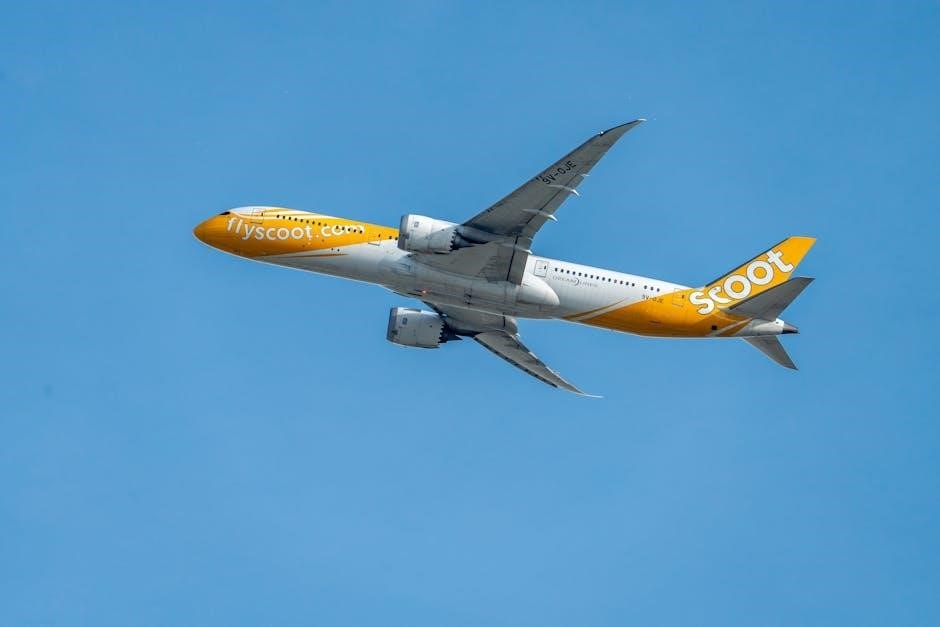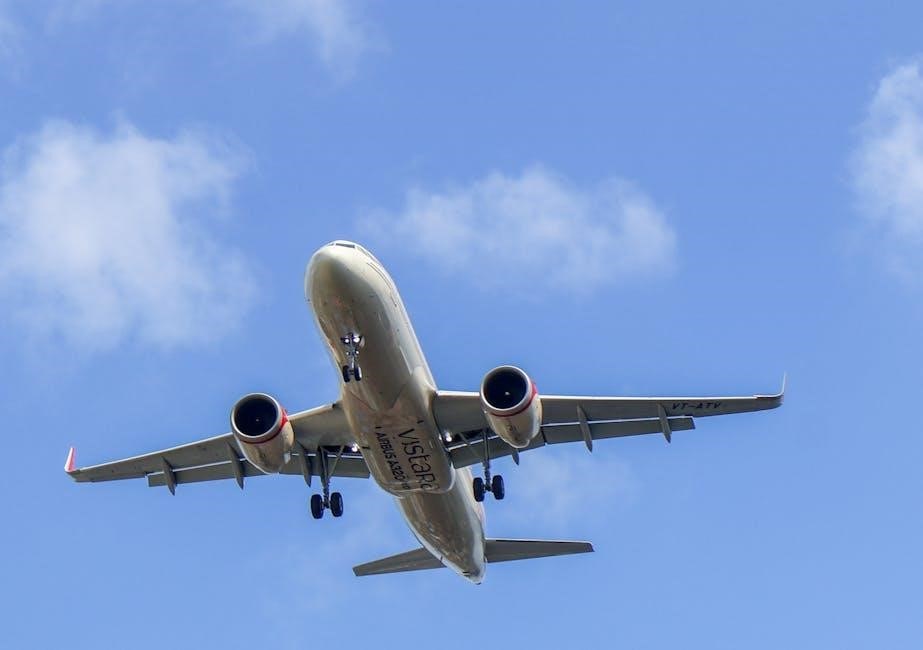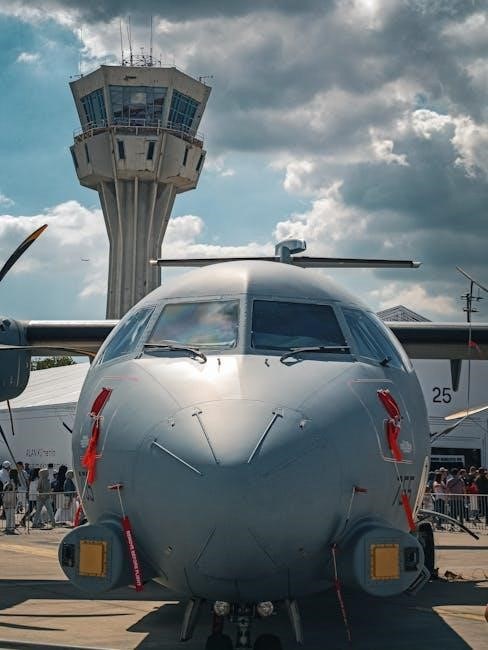by John D. Anderson Jr. is a comprehensive guide to aerospace engineering, covering aerodynamics, aircraft performance, and historical developments in aviation.
1.1 Overview of the Book
by John D. Anderson Jr. is a comprehensive textbook designed for aerospace engineering students and enthusiasts. Published by McGraw-Hill, the book covers fundamental principles of aerodynamics, flight mechanics, and the historical evolution of aviation. It explores the physics of lift and drag, aircraft performance, and propulsion systems, blending theoretical concepts with practical applications. The text also delves into modern advancements, such as unmanned aerial vehicles (UAVs) and computational fluid dynamics (CFD). With clear explanations and a structured approach, the book serves as an essential resource for understanding the science and engineering behind flight. Its historical context and real-world examples make it accessible to both students and professionals.
1.2 Importance of the Book in Aerospace Engineering
holds significant importance in aerospace engineering education and practice. As a foundational text, it bridges theory and application, providing a clear understanding of aerodynamics, propulsion, and flight mechanics. The book’s comprehensive coverage of historical developments and modern advancements, such as UAVs and CFD, equips students with a holistic perspective of the field. Its inclusion of revised problems and updated content ensures relevance, making it a valuable resource for both academic and professional use. By emphasizing core principles and real-world applications, Anderson’s work has become a cornerstone in aerospace engineering curricula worldwide, fostering innovation and excellence in the field.
1.3 Target Audience
is primarily designed for undergraduate students pursuing degrees in aerospace engineering or related fields. It serves as a foundational textbook, offering a clear and concise introduction to the principles of flight. The book is also beneficial for professionals seeking to refresh their knowledge or transition into aerospace engineering. Additionally, enthusiasts and hobbyists interested in aviation will find the text accessible and informative. Anderson’s approach ensures that complex concepts are presented in an understandable manner, making it suitable for readers with varying levels of background knowledge. This broad accessibility has made the book a popular choice for both academic and self-study purposes.

Key Concepts Covered in the Book

This book covers fundamental principles of flight, aerodynamics, aircraft performance, and aviation history, providing a comprehensive foundation in aerospace engineering with both theory and practical applications.
2.1 Fundamental Principles of Flight
The book explores the core principles governing flight, including the four forces of flight: lift, weight, thrust, and drag. It explains how these forces interact to enable aircraft to fly. Anderson details the role of wings in generating lift and the importance of airfoil shapes in creating the necessary pressure differences. The text also covers the basic components of an aircraft, such as the fuselage, wings, and control surfaces, and how they contribute to flight dynamics. By balancing these forces and understanding their relationships, the principles provide a foundation for comprehending how aircraft operate in various conditions, from takeoff to landing.
2.2 Aerodynamics and Aircraft Performance
The book delves into aerodynamics, the study of air interaction with moving objects, and its critical role in aircraft performance. Anderson explains how aerodynamic principles influence an aircraft’s ability to generate lift, reduce drag, and maintain efficient flight. He discusses boundary layers, flow regimes, and the impact of airfoil shapes on aerodynamic behavior. The text also covers drag components, such as form drag and friction drag, and their effects on performance. Anderson emphasizes the balance between aerodynamic efficiency and propulsion systems, providing a comprehensive understanding of how these factors collectively determine an aircraft’s speed, range, and maneuverability. This section is essential for grasping the practical applications of aerodynamic theory in real-world aviation scenarios.
2.3 History of Aviation and Its Development
The history of aviation is a testament to human ingenuity and perseverance. From the early experiments of Sir George Cayley and Otto Lilienthal to the groundbreaking work of the Wright brothers, the evolution of flight has been marked by relentless innovation. The Wright brothers’ successful powered flight in 1903 revolutionized transportation and warfare. World War I and II accelerated aircraft development, leading to advancements in materials and design. The introduction of jet engines in the late 1940s further transformed aviation, enabling faster and more efficient travel. Today, aviation is a global industry, with ongoing research in aerodynamics, propulsion, and sustainability shaping its future. This historical journey underscores the significance of flight in modern society.

Author Background
John D. Anderson Jr. is a renowned aerospace engineer and educator, known for his contributions to aerospace engineering, serving as a professor at the University of Maryland and working at NASA.
3.1 Biography of John D. Anderson Jr.
John D. Anderson Jr. is a distinguished aerospace engineer, educator, and author. Born in 1937, he earned his Ph.D. in Aerospace Engineering from Ohio State University. Anderson held prominent roles at NASA’s Langley Research Center and later became a professor at the University of Maryland. His expertise spans aerodynamics, propulsion, and the history of aviation. Anderson is celebrated for making complex aerospace concepts accessible, earning him numerous accolades, including the prestigious NASA Exceptional Service Medal. His work has significantly influenced both academia and industry, solidifying his legacy as a leading figure in aerospace education and research.
3.2 Contributions to Aerospace Engineering
, have educated generations of engineers, bridging theoretical knowledge with real-world applications. His influence extends to computational fluid dynamics (CFD), where his insights have enhanced simulation tools for aircraft and spacecraft design. Anderson’s contributions have shaped modern aerospace engineering, inspiring innovation and fostering advancements in hypersonic and missile technologies.
Historical Development of Flight
The history of flight traces from ancient myths to modern aircraft, with pioneers like the Wright Brothers achieving powered flight in 1903.

4.1 Early Pioneers and Their Experiments
The early pioneers of flight laid the foundation for modern aviation through their innovative experiments and perseverance. Sir George Cayley designed the first successful glider in the early 19th century, establishing principles of wing design. Otto Lilienthal conducted extensive gliding experiments in the late 19th century, refining wing shapes and aerodynamics. Octave Chanute, a prominent figure, published works that influenced many, including the Wright Brothers; Their collective contributions were instrumental in the development of controlled, powered flight, ultimately leading to the Wright Brothers’ historic achievement in 1903. These pioneers’ work not only advanced aviation technology but also inspired future generations of engineers and innovators.
4.2 Evolution of Aircraft Design
The evolution of aircraft design reflects a continuous pursuit of efficiency, safety, and performance. Early designs, such as the Wright Brothers’ biplane, relied on wood and fabric, emphasizing simplicity. World War I drove innovation, introducing metal structures and streamlined shapes. The interwar period saw the adoption of all-metal planes like the Boeing 247, which improved durability. World War II accelerated advancements, with the development of pressurized cabins and jet propulsion. The jet age brought swept wings and turbojet engines, while modern designs integrate advanced materials like composites. Computational tools now enable precise aerodynamic modeling, leading to fuel-efficient and quieter aircraft. This progression underscores human ingenuity in overcoming technical challenges.

Aerodynamics in Flight
Aerodynamics is central to understanding flight, governing aircraft performance, efficiency, and design. It explores how air interacts with surfaces, enabling lift, reducing drag, and optimizing thrust.

5.1 Understanding Lift and Drag
Lift and drag are fundamental forces in aerodynamics, essential for flight. Lift is the upward force created by the wings, countering weight, while drag is the resistance opposing motion. Anderson explains how wing shape and airflow interact to generate lift, emphasizing the role of airfoil design. Drag, influenced by factors like speed and surface roughness, must be minimized for efficient flight. The balance between these forces determines aircraft performance, with lift enabling climb and drag affecting speed and fuel efficiency. Anderson uses practical examples and equations to illustrate these concepts, making them accessible for students and engineers alike. This understanding is crucial for designing efficient aircraft and optimizing flight capabilities.
5.2 Role of Airfoil Shapes
Airfoil shapes are critical in aerodynamics, as they influence lift and drag characteristics. Anderson explains how the curved upper surface and flatter lower surface of an airfoil generate lift by creating pressure differences. The cambered design enhances lift production while minimizing drag. Different airfoil profiles are optimized for specific applications, such as high-lift wings for takeoff or streamlined shapes for supersonic flight. The book details how variations in thickness, camber, and chord length affect performance. Anderson also discusses the role of airfoils in other aircraft components, like tails and control surfaces. Understanding airfoil shapes is vital for designing efficient wings and improving overall aircraft performance, as demonstrated through practical examples and equations in the text.
5.3 Bernoulli Principle and Its Application
The Bernoulli Principle, a cornerstone of fluid dynamics, explains the relationship between velocity and pressure in fluids. Anderson highlights how this principle is fundamental to understanding lift generation on airfoils. By demonstrating that faster-moving air over a wing results in lower pressure, the principle helps explain why wings produce lift. The book applies this concept to real-world scenarios, such as aircraft wing design and airflow behavior. Anderson also discusses limitations and misconceptions, emphasizing that Bernoulli’s Principle works in tandem with other factors like airflow acceleration and energy conservation. This section provides a clear, practical understanding of how the principle is applied in aerospace engineering to optimize aircraft performance and efficiency.
Aircraft Performance and Propulsion
Aircraft performance and propulsion are critical to flight efficiency, involving engine types, fuel consumption, and thrust generation, all detailed to enhance understanding of aerospace engineering principles.
6.1 Factors Affecting Aircraft Performance
Aircraft performance is influenced by various factors, including weight, balance, and atmospheric conditions. Air density, temperature, and humidity significantly impact engine efficiency and aerodynamic behavior. Wind and weather conditions also play a role, affecting takeoff, landing, and fuel consumption. Additionally, the design of the airfoil and wing configuration influence lift and drag characteristics, which are critical for overall performance. The propulsion system’s efficiency, including thrust generation and fuel burn rates, further shapes an aircraft’s capabilities. Operational practices, such as flight altitude and speed, also affect performance metrics like range and endurance. Understanding these factors is essential for optimizing flight operations and ensuring safety.
6.2 Types of Propulsion Systems
Aircraft propulsion systems vary widely, each designed for specific performance requirements. Piston engines, commonly used in small aircraft, rely on reciprocating pistons to generate power. Turbojets, used in military and early commercial aircraft, employ high-speed exhaust gases for thrust. Turbofans, the most common type today, combine turbojet efficiency with bypass air for quieter operation. Turboprops use a turbine to drive a propeller, excelling in fuel efficiency for regional flights. Additionally, rockets are used for space exploration, while electric and hybrid systems are emerging for smaller, eco-friendly aircraft. Each system offers unique advantages, catering to different aviation needs, from speed and altitude to fuel efficiency and noise reduction.
6.3 Efficiency and Thrust Generation
Thrust generation in aircraft propulsion systems is critical for overcoming drag and achieving flight. Efficiency determines how effectively fuel is converted into thrust, impacting range and operational costs. Thrust is generated by expelling mass rearward, with the force proportional to the mass flow rate and velocity change. Modern engines optimize this through high bypass ratios, reducing fuel consumption while increasing thrust. Advances in materials and aerodynamic designs further enhance efficiency. Additionally, techniques like variable turbine vanes and cooled turbine blades improve thermal efficiency. These innovations ensure engines deliver maximum performance with minimal fuel use, balancing power and sustainability in aerospace engineering applications.

Modern Applications of Flight Technology
Drones, UAVs, and CFD advancements revolutionize aerospace, enabling precise surveillance, efficient delivery, and improved aircraft design, while materials science innovations enhance performance and sustainability in modern aviation systems.
7.1 Unmanned Aerial Vehicles (UAVs)
Unmanned Aerial Vehicles (UAVs), or drones, represent a transformative application of flight technology. Anderson’s text highlights their design principles, emphasizing aerodynamics, propulsion, and control systems. UAVs are increasingly used in surveillance, agriculture, and delivery, leveraging autonomous navigation and real-time data processing. Their compact size and agility enable operations in confined spaces, while advanced sensors enhance precision in mapping and environmental monitoring. The integration of AI and machine learning further optimizes UAV performance, making them indispensable in both military and civilian sectors. Anderson’s work underscores the importance of understanding fundamental flight mechanics in developing these systems, bridging theory with practical innovation in modern aerospace engineering.

7.2 Computational Fluid Dynamics (CFD)
Computational Fluid Dynamics (CFD) is a revolutionary tool in aerospace engineering, enabling precise simulation of airflow and fluid behavior. Anderson’s text explores its role in analyzing aerodynamic performance, optimizing aircraft designs, and predicting flight characteristics. CFD allows engineers to model complex scenarios, such as turbulence and heat transfer, without physical prototypes. This reduces development costs and accelerates innovation. By solving the Navier-Stokes equations, CFD provides insights into pressure distributions, velocity fields, and thermal interactions. Its applications span from improving UAV efficiency to designing advanced spacecraft. Anderson highlights how CFD bridges theoretical principles with practical applications, making it indispensable for modern aerospace research and development. It empowers engineers to refine designs and enhance performance, driving progress in flight technology.
7.3 Advances in Materials Science
Advances in materials science have significantly impacted aerospace engineering, enabling the development of lighter, stronger, and more durable aircraft. Anderson’s text highlights the importance of materials like carbon fiber reinforced polymers (CFRP) and titanium alloys, which enhance aircraft efficiency and performance. These materials reduce weight while maintaining strength, improving fuel efficiency and range. Additionally, the use of smart materials and composites has revolutionized aircraft design, offering improved thermal resistance and adaptability. Such innovations are critical for next-generation aircraft, including UAVs and hypersonic vehicles. Anderson emphasizes how these advancements are integral to modern flight technology, ensuring safer and more efficient aviation systems. They pave the way for future breakthroughs in aerospace engineering.
Anderson’s text serves as a foundational resource for aerospace education, offering clarity and comprehensive coverage of flight principles, making it indispensable for students and educators alike.
8.1 Curriculum Integration
8.2 Learning Approach and Pedagogy
8.3 Student Resources and Supplements
Solutions Manual and Supplementary Materials
The solutions manual provides detailed answers to textbook problems, aiding students in understanding complex concepts. Supplementary materials include online resources and study guides, enhancing learning effectiveness.

9.1 Overview of the Solutions Manual
by John D. Anderson Jr. is a comprehensive resource designed to accompany the textbook. It provides detailed, step-by-step solutions to the end-of-chapter problems, enabling students to understand complex aerodynamic and aerospace engineering concepts. The manual is structured to align with the textbook chapters, ensuring seamless integration. It caters to both undergraduate students and instructors, offering a clear explanation of equations, derivations, and practical applications. The solutions manual is particularly useful for self-study, homework assistance, and exam preparation. It also serves as a valuable reference for professionals seeking to refresh their knowledge of aerospace fundamentals. The manual is available as a separate resource, enhancing the learning experience for those studying from the textbook.
9.2 Additional Study Resources
can benefit from various additional study resources. Online platforms offer lecture notes, video tutorials, and interactive simulations that complement the textbook. Many universities provide study guides and practice problems tailored to the book’s content. The publisher’s companion website often includes multimedia resources, such as animations and quizzes, to enhance understanding. Additionally, mobile apps and online forums allow students to engage with peers and instructors for clarification on complex topics. These resources collectively provide a well-rounded learning experience, enabling students to grasp the fundamentals of flight and aerospace engineering effectively. They also cater to different learning styles, ensuring a deeper comprehension of the subject matter.
